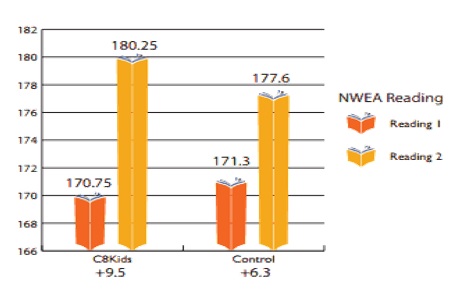40 Day Challenge
For 40 days reflect each day on these 5 heart centered words:
Compassion,
Courage,
Confidence, Consciousness (Awareness), and Community.
Write the words down, and take a few notes of what comes to mind, of what you learn or see or hear that is related. We will have information on the CEI website about the next steps. |

Roadmap to Rigor Rubric NAESP has developed a rubric that will help principals and teachers engage in discussions about rigor and plan for integrating greater rigor into instruction in their schools. While it can be used as an observation and feedback tool, many principals may find it easier to use this tool to help teachers become more aware of the components that facilitate greater rigor.
The rubric addresses higher-order thinking skills, deep understanding, problem solving, and metacognition. The roadmap also includes an appendix with an annotated bibliography and additional resources. NAESP also offers Rigor Workshops that explore strategies and processes to help students move to deeper levels of understanding through metacognition, higher level expectations, and problem solving. Level I is basic. Level II provides guidance with use of the Rigor Roadmap. If you are interested in reviewing the Rigor Roadmap and providing feedback to NAESP, or for more information on the workshops, please contact Ed Millliken
emillliken@naesp.org or
cmason@naesp.org. |
|
Don't Laugh at Me
Download a free packet of Peter Yarrow's material here.
Listen to the music class of third graders of Del Norte (Colorado) Elementary sing the title song here.
|
|
C8 Activities
Special Discount on
Use the code: NAESP13 to receive a 10% discount. |
|
Contact Us
For more information on our services and modules or for a free 2-hour consultation, contact Dr. Christine Mason
cmason@naesp.org
toll-free 800-386-2377
or 703-684-3345
To help us meet your needs, please include in your email the answers to the following questions:
1. Primary concern or need:
2. Proposed dates of service:
3. # of teachers:____
4. What you expect from CEI:
|
|
Editor:
Carolyn Lieberg, M.A.
|
|
Visit Our Websites
The Newsletter Archive page on CEI's website contains a library of previous Wow! Ed editions.
Also visit the Publications page on the NAESP website to read additional publications designed to meet the needs of today's school leaders.
|
|
|
|
Dear Educator,
This issue of Wow! features work that takes us through a time warp. Consider the many children in your schools who are academically challenged. What if by spending a few more hours a week at a computer, neuron pathways in their brains could be strengthened -- strengthened in such a way that students could leap ahead cognitively and academically? What if such efforts might be equivalent to say, perhaps, 5 months of academic drill? What if once these neuron pathways are modified, these brains are essentially "reset" with a greater capacity? Would you be interested? Then read on...
|
 | Activate by C8 Sciences: Both Assessment and Intervention
|
An anonymous expert reviewer for the Director of the National Institute of Health said that C8 Sciences' brain-training program to improve executive function in 5-9-year-old children was "easily the most sophisticated brain training program ever attempted..." What is not as widely known is that the C8 program is also a powerful assessment tool providing schools with information about each child's cognitive strengths and weaknesses that can help capitalize on strengths and address weaknesses early in school years.

Dr. Bruce Wexler and a student working on a C8 program.
C8 scientists wanted to measure whether their brain-training program was actually helping children improve their thinking abilities. To do this, they built four widely used tests of executive functioning into the training program; children automatically get the tests when they start the brain-training program and again after they complete it. Three tests come from the NIH Toolbox of tests selected by an expert committee of cognitive psychologists. The fourth test is the Go/No-go test of response inhibition. C8 created web-based versions of the tests and materials to enable reliable administration in classroom settings for the first time. With test scores from thousands of children in the C8 data base for comparison, schools are provided age-specific percentile scores for each child on each test. In addition, C8 scientists have created algorithms to integrate the data from all the tests into an overall assessment.
The second and third evaluation components come from information recorded during the training games themselves. The training games have hundreds of progressively more demanding difficulty levels. By comparing the progress each child makes through these difficulty levels to thousands of other children, C8 provides early identification of children with special needs or talents. Schools have found this particularly helpful in understanding the needs and potential of ESL students.
In order to continuously improve the C8 brain-training programs, C8 saves every mouse click of every child during the brain-training exercises. C8 scientists use this information to evaluate and improve detailed design features of the training programs. This data also provides the third evaluation component for schools. Algorithms created by C8 scientists analyze the patterns of correct and incorrect responses during the training programs to create a profile of each child's areas or relative cognitive strengths and weaknesses that supplement the information from the NIH Toolbox and Go/No-go tests. These profiles are similar to what is provided in a neuropsychological assessment.
When C8 founder and chief scientist Bruce Wexler goes over assessment results with teachers and principals, he can't get them to leave the data from one class to look at the next. "They want to talk about every child in detail," he explains, "Look at Amy's working memory score, I didn't realize she was so good," or "Look at John's problems with response inhibition; I knew he has some difficulty in self-control but I will take this problem more seriously now."
At one school where all children in grades 1-3 did the C8 program, Dr. Wexler told the gathered teachers and principal that the top performer by far in the whole school was in the next class. "Guess who it is" he asked. They guessed four times and were wrong! A gasp went through the room when they saw the data. "Hector, Hector got all those points!" An excited discussion followed about Hector and how best to engage his considerable talents.
At another school, teachers were considering special education services for a young boy with limited English language skills before C8 assessments revealed his considerable strengths. Some schools now use the assessments and individual cognitive profiles routinely in teacher planning meetings and parent-teacher conferences. Others are merging the new data made available by C8 assessments with their own data bases. One point of interest is to identify children whose assessments suggest they could be doing better academically. Special C8 reports for principals provide school-wide summaries and individual class and student data that provide a look into the classroom.
|

|
Neuroscience: Now and in a World Not Too Far Away
| |
By Christine Mason, Ph.D.
Imagine a world where, with a flick of a switch, we could reshape brains, increase the efficiency of brain functioning and improve memory. Go back to the year 1995. Perhaps you saw the Keanu Reeves' movie Johnny Mnemonic (based on a short story by William Gibson). Keanu has a brain chip implant, which, while expanding his memory, creates a wealth of other problems.
In the field of neuroscience, currently, there is a rapidly expanding number of programs available to facilitate learning, improve the brain's executive functioning, and, in essence, rewire the brain. Are we witnessing the melding of SciFi with our everyday reality?

An interesting source for comparing SciFi to Neuroscience is Clarkesworld Magazine. A few excerpts from a blog on March 2010 by Luc Reid lay the groundwork for understanding how what we are learning about the brain is so different than what we knew 20-30 years ago.
For instance, the notion of Total Recall (the identically named film does not work in this instance) is also called eidetic memory, from the Greek word meaning "seen." In this version of memory, people know things not because those things are being associated with previous knowledge but because everything has literally been seen.
Perhaps the invention of movie cameras gave us the notion that our minds might work in this fashion -- recording all, even if we were not conscious of "seeing" it during the "filming." Investigations reveal that we are not constantly filming, even if the legal system could make good use of that skill ("Tell the court exactly what happened. Was the man you saw wearing a green tie and carrying a paper bag?"). Instead, our memories form by our locking in the salient events or novel experiences. Aspects, such as lines, color, and motion, are in fact recorded by different parts of the brain, according to developmental molecular biologist John Medina, who describes this parsing in his book, Brain Rules (2009).
Another misunderstanding that has been revised in recent years concerns brain plasticity and the degree to which adult brains actually continue to grow or learn. Brian Trent described

human neuron activity shortly after the Blue Brain Project succeeded in creating an initial supercomputer that could imitate a brain with 10,000 neurons. The aim of the project, founded in May 2005 by the Brain and Mind Institute of the École Polytechnique Fédérale de Lausanne in Switzerland, was to create a virtual brain in a supercomputer. The gap, though, between the initial constructed "brain" and natural brains is vast. Trent underscored this when he noted that our brains contain about a hundred billions neurons, each making a synaptic connection with 7,000 other neurons. The brain is constantly learning; therefore it constantly updates and re-wires itself. This realization illustrated to researchers, according to Trent, that the brain is learning all the time. Hence, funding for the Blue Brain Project continues and the research is evolving.
As science fiction writers have helped us to understand, in attempting brain experiments, complexity can lead to mis-steps. Will we eventually replace human with artificial brains or be able to upload brains onto computers so that brains, as Brian Trent has described, will be able to live on after death? One complication for artificial-brain developers is that in our brains the neurons combine the activity of conduction and the content: in computer-talk, neurons are both the software and the hardware.
Will a new brain project compete with the human brain? Eventually, perhaps. And then scientists will look back on the Blue Brain Project as we nostalgically think of Alexander Graham Bell calling for Mr. Watson one room away.
How these developments may influence education can only be speculation at this point. But the imaginations that compare science with science fiction inspire learning and exploration in people of all ages. We may not fathom how new developments will affect education, but we can be sure that they will indeed have an impact.
References
Medina, J. (2009) .Brain rules: 12 principles for thriving at home, school and work. Seattle, WA: Pear Press.
|
 |
iPads,Tablets and Learning: Early Results Are Promising
| |
By Carolyn Lieberg, MAW
While we wait for the research on how the world of tablets and iPads are affecting children's learning, we will have to rely on the anecdotal reports and the advice of educational experts.
Some of the research that encourages educators to be enthusiastic about using devices in the classroom was listed on Secure Edge Networks in their IT Solutions blog. The writer reported positive outcomes in three studies. In Auburn, Maine, kindergartners using iPads scored higher on literacy tests; at the KIPP Academy in Houston, Texas, students in the "flipped classrooms," which employed iPads, scored 49% higher than students in traditional classrooms with no iPads, and in a third study involving Motion Math, an iPad math game, fifth graders who played regularly for 20 minutes per day for five days had scores that were 15% higher on average (Wainright, 2013).

In addition to the hands-on use, one issue that affects the use of iPads in school is the cost. But fiscal concerns are not just about the expense of the devices. Earlier this year, Peg Tyre, Pulitzer-prize winning reporter and author, looked at some of the experiments in technology use in the classroom. She cited the Rocketship schools, which feed their low-income K-5th grade students "a steady diet of computer-delivered lessons" (Tyre, 2013), because the technology helps them fill gaps in learning, which allows Rocketship's teachers to work on critical thinking skills in the classroom. She notes, too, that Rocketship's use of technology allows them to save money on personnel.
The financial picture is one that suggests caution. Some teachers are using the technology well, but for many, it is a brighter version of a text -- and not worth the expenditure. Tyre cautions educators to "make sure hype doesn't overtake good judgment."
As research studies on learning gain a foothold, they will likely need to be blended by experts on on screen time. A long-term study (The Millennium Cohort Study) in Great Britain followed 19,000 children born in 2000 and 2001. According to their follow-up as reported in March 2013, those children who watched three hours or so of TV or DVDs daily had marked behavior problems. Interestingly, the 11,000 children who had spent the same amount of time playing video games behaved normally for their age (Bilton, 2013). The issue of screen time may shift to measurements of passivity versus active engagement when it comes to deciding how various gadgets affect learning.
Best Academic Apps. Enthusiasm for ways to use electronic tablets and iPads is well illustrated by the wide range of educational applications that creative educators are developing. Among those in the "best" lists from 2012 were apps to help students learn geography, history, art, math, language arts that include both grammar and conversation, reading, Spanish, Japanese, and handwriting. Games create the appeal, and the results are impressive.
Meanwhile, the scientific findings for the mix of neurons and iPads will have to wait. A web search for the two keywords produces apps to learn about Ned the Neuron as well as plenty of "wallpaper" to use and enjoy as a screensaver.
References
Bilton, N. (2013, March 31). The child, the tablet and the developing mind technology | Personal Tech | Business Day The New York Times.
Tyre, P. (2013, January 31), iPads: Are education gadgets really helping kids learn? Take Part: Online Resources for Active Learning, Active Citizenship. Retrieved Sept. 9, 2013 from http://takepart.org/manageContent.aspx?object.id=10229&mta_htm=home
Wainwright, A. (2013, April 12) Effects of iPads in the classroom on elementary education. IT Solutions Blog. Secure Edge Networks. Retrieved Sept. 7,2013 from http://www.securedgenetworks.com/
|
 |
Common Core, School Readiness, and Executive Functioning: Bridging the Gap in Underachievement for Students in Poverty
| |
By Suzan Mullane, MS Ed. and Christine Mason, Ph.D.
The average performance of systems is not the most important factor; rather, the gap between low and high performers is....The problem of inequality is becoming more pronounced and more entrenched decade by decade...a social time bomb. ~~ Michael Fullan
With the advent of Common Core State Standards, bridging achievement gaps is a challenge for students, teachers, and school administrators. Several states have provided on-line instructional support tools to help "un-pack" the Common Core Standards and provide guidance to support these new expectations. In so doing, states such as North Carolina have alerted educators to some of the discrepancies in individual readiness:
Mathematically proficient students in kindergarten begin to develop effective dispositions toward problem solving. In rich settings in which informal and formal possibilities for solving problems are numerous, young children develop the ability to focus attention, test hypotheses, take reasonable risks, remain flexible, try alternatives, exhibit self-regulation, and persevere (Copley, 2010).

Students who enter school with little awareness of numbers, number value, rote counting, or "number sense" are at a significant disadvantage. In fact, early growth in math performance and numerical awareness predict math achievement by third grade. Arriving at school with inequities in skills and opportunities, often translates to more variation in fluency and degree of skill mastery, and ongoing learning challenges (Jordan, et al., 2009).
Education stakeholders have long known the relationship between academic achievement and socio-economic status. Children living in poverty start school at a disadvantage. Their health, behaviors, and skills make them less prepared for kindergarten than children growing up under better economic conditions. Fewer than half (48 percent) of children from low socio-economic families are school-ready at age five as measured by early math and reading skills, learning-related and problem behaviors, and overall physical health (Isaacs, 2012).
For some teachers who have seen students at their school struggle, it can be all too easy to view students from a deficit lens. This struggle can be related to socio-economic and cultural differences that impact school readiness. For example, a disproportionate number of minority children are identified for special education services prematurely. (Harry and Klinger, 2007). Teachers, rather than learning to understand the differences and how to build skills with these youth, turn far too quickly to referrals and labeling.
However, there are strategies to help students catch up. Jefferson County Schools in Kentucky, for example, are beginning to use the Singapore Math program to help teach problem solving and conceptual understanding (Konz, 2013) (see also Wow! Ed, March 2012, archived at www.edimprovement.org)
Recent advances in neuroscience may provide an extra boost for students, according to Dr. Bruce Wexler, a neuroscientist at Yale:
The degree to which our brains are shaped after birth from stimulation from the environment is more true in humans than any other animal. The brain strengthening is especially important in the case of children who come from poor backgrounds and subsequently struggle in school (Disare, 2012).
Students who enter school with math deficits may also exhibit difficulties such as attention deficits or problems with memory that may further impede learning. In these cases, specific "brain exercises" may be useful in ameliorating these circumstances. Wexler, a neuroscientist at Yale, found that a series of computerized and physical activity exercises may strengthen the efficiency with which the brain processes information.
Wexler developed a program "Activate" for K-3rd graders (www.c8sciences.com). The program uses a content neutral approach, making it particularly useful for English language learners or learners who may not be at grade-level and is effective for English Language Arts as well as math. The program focuses on building eight executive functions and includes more than 300 levels of cognitive exercises, many of which also include sub-levels based on speed. As students progress in the program, more cognitive tasks are layered into the sessions, and the length of each session slowly increases. As the students play, the program's online error diagnostics tracks when students' performance begins to lag and automatically adjusts to their level. Real-time corrective strategy messaging will give students encouragement, personalized tips, and advice during game play. A unique feature of this program is the cross-training that occurs with the use of physical exercises that stimulate similar brain functions.
It has resulted in improvements in both these executive functions and also in academic achievement. The computer programs automatically administer tests from the NIH Toolbox of measures of executive function before beginning and after completing the brain training exercises. Working memory scores more than doubled in children participating in the Activate program in Bristol, CT, while showing only very limited improvement in a control group tested twice without having taken the program (Figure 1).
 | | Figure 1. Working memory gains in children who participated in Activate compared to a control group tested twice without participation in the program. |
In a school in Brooklyn, NY, children who participated in more sessions of the Activate program showed statistically significantly greater gains in working memory and also self-regulation and inhibitory control as measured by the Go/No-Go indicator.
In children evaluated five months after the program ended, gains were maintained on both tests. The same school in Brooklyn went from the bottom third to the top third in New York City rankings in reading and math proficiency after implementing the program school-wide. Here again "dose effects" were evident as children who participated in more sessions of Activate made statistically significant greater gains in reading levels (Figure 2).
 | | Figure 2. Gains in reading levels are greater with more brain training. |
Similarly positive effects on school-administered standardized tests were seen in a Hamden, CT, school where children who participated in the C8 program were 2.5 times as likely to show greater than 50 point gains in Blue Ribbon subtests reflecting executive function than were children in a control group (Figure 3).
 | | Figure 3. Children who participate in the C8 program are more likely to show large gains in Blue Ribbon subtests related to executive function than are children in a control group. |
In an NIH-funded study comparing the effects of Activate in children with ADHD and typically developing children in both Hamden, CT, and Beijing, China, children with ADHD were less accurate and slower on NIH Toolbox tests of sustained attention prior to the C8 program and closed the gap after participation. All children showed robust gains in working memory (Figure 4).
 | | Figure 4. Both children with ADHD and typically developing children show robust gains in working memory after participating in the C8 program. |
References
Copley, J. (2010). The young child and mathematics. Washington DC: NAEYC. Quoted in Instructional Support Tools for Achieving New Standards, p.3. North Carolina Department of Public Instruction.
Disare, M. (2012, October 17). Yale psychiatrists build education program. Yale Daily News. Yale University. New Haven, CT.
Harry, B. & Klingner, J. (2007) Discarding the deficit model: Improving instruction for students with learning needs. Educational Leadership, 64, 5, 16-21.
Isaacs, J. B. (2012). Starting school at a disadvantage: The school readiness of poor children. The School Genome Project. Washington, DC: Center on Children and Families at Brookings. Brookings Institution.
Jordan, N. C, Kaplan, D., Ramineni, C., & Locuniak, M. N. (2006). Early math matters: Kindergarten number competence and later mathematics outcomes. Developmental Psychology, 45, 3, 850-867.
Konz, A. (2013, August 18) Kentucky schools look to Singapore to raise math scores. USA Today from The Courier-Journal, Louisville, KY.
|
|
Wearing our Brains on our Sleeves?
Will we eventually be able to wear our brains on our sleeves? Is that out of the realm of possibility? Consider the latest Internet-connecting digital wristwatches or even the hand-held memory devices we carry with us. What are the implications for principals and teachers? Will we be able to buy brain cells and will technology truly supplant teaching? Will a brain-pump be created that is similar to the insulin pumps we have today? When we say "fill 'er up" will be talking about brainfuel? Continue to tune in as we continue this investigative reporting, taking you to the realm of the Blue Brain and beyond.
Christine Mason, Ph.D.
Director, Center for Educational Improvement
|
|
|